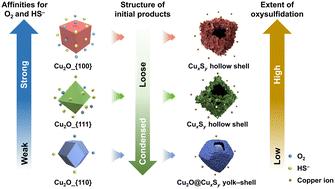当前位置:
X-MOL 学术
›
Environ. Sci.: Nano
›
论文详情
Our official English website, www.x-mol.net, welcomes your
feedback! (Note: you will need to create a separate account there.)
Facet-dependent oxysulfidation of Cu2O nanomaterials: implications for improving the efficacy of nanopesticides
Environmental Science: Nano ( IF 5.8 ) Pub Date : 2024-10-14 , DOI: 10.1039/d4en00545g Tingting Du, Wenyu Guan, Zhanhua Zhang, Chuanjia Jiang, Pedro J. J. Alvarez, Wei Chen, Tong Zhang
Environmental Science: Nano ( IF 5.8 ) Pub Date : 2024-10-14 , DOI: 10.1039/d4en00545g Tingting Du, Wenyu Guan, Zhanhua Zhang, Chuanjia Jiang, Pedro J. J. Alvarez, Wei Chen, Tong Zhang

|
Copper (hydr)oxide nanomaterials are an important class of nanomaterials with various applications, including next-generation pesticides. The efficacy of these materials is largely affected by oxysulfidation, one of the most important transformation processes in the environment. Here, we show that the extent and route of oxysulfidation are facet-dependent for these materials. Specifically, oxysulfidation of Cu2O_{100} and Cu2O_{111}—two Cu2O nanomaterials with predominantly exposed {100} and {111} facets—is fast and complete, with only a hollow shell left at the end of the experiment. In comparison, oxysulfidation of Cu2O_{110}, a nanomaterial with {110} facet, is much less complete, in that, the end-product exhibits a yolk–shell structure with a large cuprite core. The varied degrees of oxysulfidation are attributable to the facet-dependent adsorption affinities of Cu2O for both oxygen and sulfide ions, leading to the formation of different initial oxysulfidation products. Unlike the porous coatings of yarrowite on Cu2O_{111} and a mixture of yarrowite and covellite on Cu2O_{100}, the condensed layer of djurleite formed on Cu2O_{110} passivates the material by sealing the surface of Cu2O, hindering subsequent copper dissolution. Consequently, Cu ions released from Cu2O_{100} and Cu2O_{111} are 2.2 and 2.4 times higher than that from Cu2O_{110}. These findings underline the important role of exposed facets in dictating the interfacial processes of soft metal-based nanomaterials, and have important implications for improving the efficiency of nanopesticides in redox dynamic rhizospheres to minimize the environmental impacts associated with the overuse of conventional pesticides.
中文翻译:

Cu2O 纳米材料的刻面依赖性氧硫化:对提高纳米农药功效的影响
氧化铜(氢)氧化物纳米材料是一类重要的纳米材料,具有多种应用,包括下一代杀虫剂。这些材料的功效在很大程度上受氧硫化的影响,氧硫化是环境中最重要的转化过程之一。在这里,我们表明这些材料的氧硫化程度和途径是刻面依赖性的。具体来说,Cu2O_{100} 和 Cu2O_{111}(两种 Cu2O 纳米材料,主要暴露{100}面和 {111} 面)的氧硫化反应快速而完整,实验结束时只剩下一个空壳。相比之下,Cu2O_{110}(一种具有{110}面的纳米材料)的氧硫化作用要不完全得多,因为最终产物表现出具有大赤铜矿核的蛋黄壳结构。不同程度的氧硫化作用归因于 Cu2O 对氧离子和硫化物离子的刻面依赖性吸附亲和力,导致形成不同的初始氧硫化产物。与 Cu2O_{111}上的蓍草石多孔涂层以及 Cu2O_{100}上的蓍草石和钝石混合物不同,在 Cu2O_{110}上形成的蓍草石凝聚层通过密封 Cu2O 的表面来钝化材料,从而阻碍随后的铜溶解。因此,Cu2O_{100} 和 Cu2O_{111}释放的 Cu 离子分别是 Cu2O_{110} 释放的 2.2 倍和 2.4 倍。 这些发现强调了暴露面在决定软金属基纳米材料的界面过程中的重要作用,并对提高纳米农药在氧化还原动态根际中的效率以最大限度地减少与过度使用传统农药相关的环境影响具有重要意义。
更新日期:2024-10-14
中文翻译:

Cu2O 纳米材料的刻面依赖性氧硫化:对提高纳米农药功效的影响
氧化铜(氢)氧化物纳米材料是一类重要的纳米材料,具有多种应用,包括下一代杀虫剂。这些材料的功效在很大程度上受氧硫化的影响,氧硫化是环境中最重要的转化过程之一。在这里,我们表明这些材料的氧硫化程度和途径是刻面依赖性的。具体来说,Cu2O_{100} 和 Cu2O_{111}(两种 Cu2O 纳米材料,主要暴露{100}面和 {111} 面)的氧硫化反应快速而完整,实验结束时只剩下一个空壳。相比之下,Cu2O_{110}(一种具有{110}面的纳米材料)的氧硫化作用要不完全得多,因为最终产物表现出具有大赤铜矿核的蛋黄壳结构。不同程度的氧硫化作用归因于 Cu2O 对氧离子和硫化物离子的刻面依赖性吸附亲和力,导致形成不同的初始氧硫化产物。与 Cu2O_{111}上的蓍草石多孔涂层以及 Cu2O_{100}上的蓍草石和钝石混合物不同,在 Cu2O_{110}上形成的蓍草石凝聚层通过密封 Cu2O 的表面来钝化材料,从而阻碍随后的铜溶解。因此,Cu2O_{100} 和 Cu2O_{111}释放的 Cu 离子分别是 Cu2O_{110} 释放的 2.2 倍和 2.4 倍。 这些发现强调了暴露面在决定软金属基纳米材料的界面过程中的重要作用,并对提高纳米农药在氧化还原动态根际中的效率以最大限度地减少与过度使用传统农药相关的环境影响具有重要意义。































 京公网安备 11010802027423号
京公网安备 11010802027423号